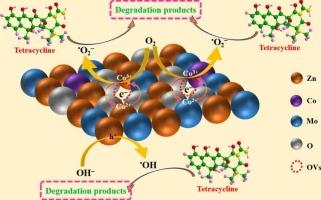Heightened photocatalytic performance of ZnMoO4 by incorporation of cobalt heteroatom to enhance oxygen defects for boosted pharmaceutical degradation
IF 6.3
2区 工程技术
Q1 ENGINEERING, CHEMICAL
引用次数: 0
Abstract
Water pollution by pharmaceutical drugs has raised concerns as this negatively impacts human health and the entire ecological system. Herein, a highly efficient Zn1-xCoxMoO4 photocatalyst with oxygen vacancy (ZCMx-OV) and enhanced visible light absorption was designed and synthesized through heteroatom inclusion. The x-ray photoelectron spectroscopy and electron paramagnetic resonance confirmed the formation of oxygen vacancies, while ultraviolet-visible analysis indicated enhanced visible light absorption. The rate of tetracycline (TC) elimination by optimal ZCM2 was 6.88, 1.75, and 1.47 times higher than those of ZM, ZCM1, and ZCM3, respectively. Again, the rate of ZCM2 towards tetracycline degradation was 1.38, 1.32, and 1.26 folds in deionized water compared to diverse water matrices such as snow, tape, and lake water. Tetracycline was mainly removed by holes (h+) and superoxide (•O2−) as confirmed by trapping experiments and EPR analysis. The density functional theory (DFT) Fukui index predictions confirmed vulnerable bonds of TC attacked by oxygen radicals. This study provides a fresh perspective and valid reference for designing highly active and efficient photocatalytic material through heteroatom introduction for pharmaceutical degradation and can be extended to other pollutants of emerging concern.

通过掺入杂原子钴提高 ZnMoO4 的光催化性能,从而增强氧缺陷,促进药物降解
药物造成的水污染已引起人们的关注,因为这会对人类健康和整个生态系统产生负面影响。本文设计并通过杂原子包合合成了一种具有氧空位(ZCMx-OV)和增强可见光吸收的高效 Zn1-xCoxMoO4 光催化剂。X 射线光电子能谱和电子顺磁共振证实了氧空位的形成,紫外可见光分析表明可见光吸收增强。最佳 ZCM2 的四环素(TC)消除率分别是 ZM、ZCM1 和 ZCM3 的 6.88、1.75 和 1.47 倍。同样,在去离子水中,ZCM2 对四环素的降解率是雪水、胶带水和湖水等不同水基质的 1.38、1.32 和 1.26 倍。捕获实验和 EPR 分析证实,四环素主要被空穴(h+)和超氧化物(-O2-)去除。密度泛函理论(DFT)福井指数预测证实了四环素被氧自由基攻击的脆弱键。这项研究为通过引入杂原子设计高活性、高效的光催化材料以降解药物提供了新的视角和有效的参考,并可扩展到其他新出现的污染物。
本文章由计算机程序翻译,如有差异,请以英文原文为准。
求助全文
约1分钟内获得全文
求助全文
来源期刊

Journal of water process engineering
Biochemistry, Genetics and Molecular Biology-Biotechnology
CiteScore
10.70
自引率
8.60%
发文量
846
审稿时长
24 days
期刊介绍:
The Journal of Water Process Engineering aims to publish refereed, high-quality research papers with significant novelty and impact in all areas of the engineering of water and wastewater processing . Papers on advanced and novel treatment processes and technologies are particularly welcome. The Journal considers papers in areas such as nanotechnology and biotechnology applications in water, novel oxidation and separation processes, membrane processes (except those for desalination) , catalytic processes for the removal of water contaminants, sustainable processes, water reuse and recycling, water use and wastewater minimization, integrated/hybrid technology, process modeling of water treatment and novel treatment processes. Submissions on the subject of adsorbents, including standard measurements of adsorption kinetics and equilibrium will only be considered if there is a genuine case for novelty and contribution, for example highly novel, sustainable adsorbents and their use: papers on activated carbon-type materials derived from natural matter, or surfactant-modified clays and related minerals, would not fulfil this criterion. The Journal particularly welcomes contributions involving environmentally, economically and socially sustainable technology for water treatment, including those which are energy-efficient, with minimal or no chemical consumption, and capable of water recycling and reuse that minimizes the direct disposal of wastewater to the aquatic environment. Papers that describe novel ideas for solving issues related to water quality and availability are also welcome, as are those that show the transfer of techniques from other disciplines. The Journal will consider papers dealing with processes for various water matrices including drinking water (except desalination), domestic, urban and industrial wastewaters, in addition to their residues. It is expected that the journal will be of particular relevance to chemical and process engineers working in the field. The Journal welcomes Full Text papers, Short Communications, State-of-the-Art Reviews and Letters to Editors and Case Studies
 求助内容:
求助内容: 应助结果提醒方式:
应助结果提醒方式:


